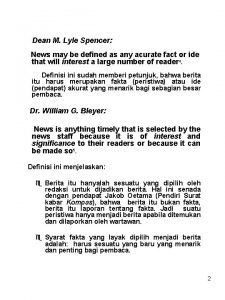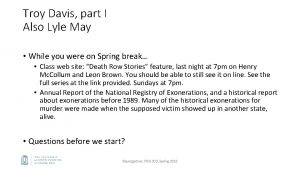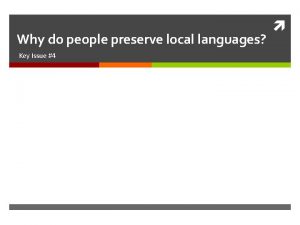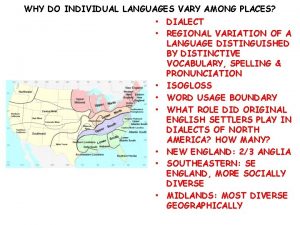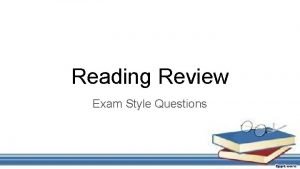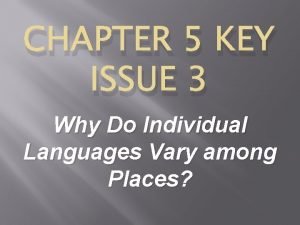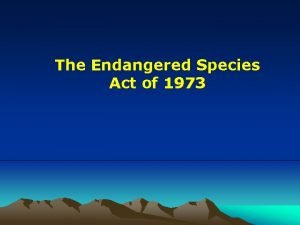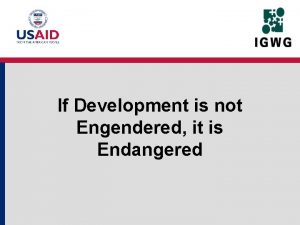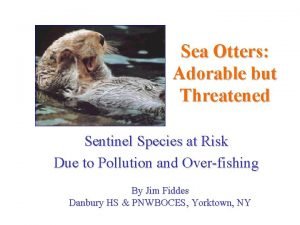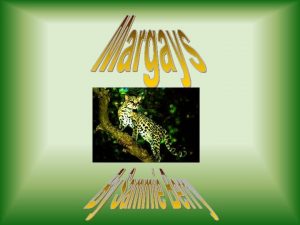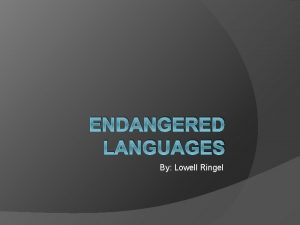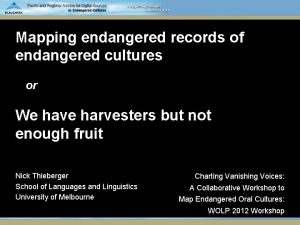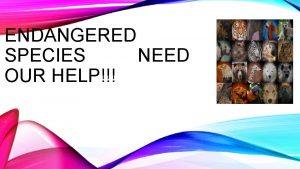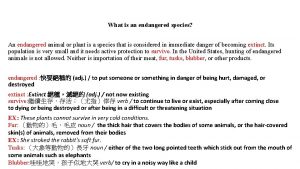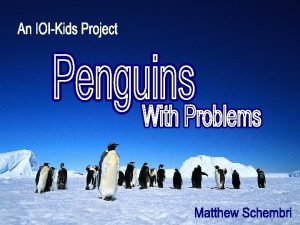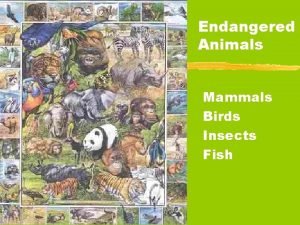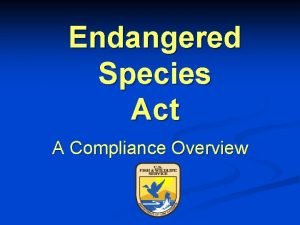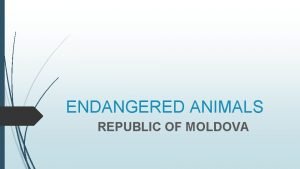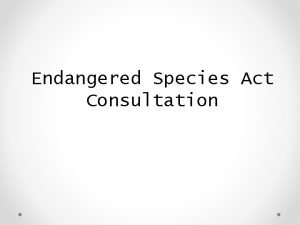Why the Catalogue of Endangered Languages Project Lyle



















- Slides: 19

Why the Catalogue of Endangered Languages Project? Lyle Campbell (lylecamp@hawaii. edu)

News item: April 18, 2012: Headline: “Alaska Native Language Loses Last Fluent Speaker” “The world and the Holikachuk Athabascan language suffered a great loss with the passing of Wilson “Tiny” Deacon on March 10, 2012. . . he was the last fluent speaker of his language. ” [Indian. Country. Today. com Media Network]

Goals: Report on ELCat, The Catalogue of Endangered Languages, on its purpose, its findings to date, and why it is necessary. Did you know? (1) There around 7, 000 languages spoken in the world? (2) Over 3, 000 of them are endangered (43%). (3) 634 are extinct – 141 of these recently extinct (22%). (4) Whole language families are gone – all the languages of 100 families are extinct, from the c. 420 language families – nearly 25% of the linguistic diversity of the world has been lost forever.

Need: The endangered languages crisis is one of the most important problems facing humanity today, posing moral, practical, and scientific issues of enormous proportions. ELCat goal: to create a definitive and authoritative resource on the endangered languages of the world. No other existing source provides all the kinds of information needed by those concerned with endangered languages. These goal for kinds of information include: Producing new knowledge; Supplying information missing in other sources; Correcting errors (misidentification of languages, missing languages, languages that are not real or distinct from other languages, classifications of languages) Updating and correcting information (number of speakers, location, etc); Degree of endangerment; documentation index.

Catalogue of Endangered Languages Project Supported by a National Science Foundation grant (collaborative University of Hawai‘i Mānoa and Eastern Michigan University), website constructed by Google. org at www. endangeredlanguages. com. Directed by Lyle Campbell (UHM) and Helen Aristar-Dry and Anthony Aristar (Linguist. List, EMU). Univerisity of Hawai’i Manoa is responsible for the languages of the Americas, Asia, the Caucasus, Europe, and the Pacific, for the Endangerment Scale and for the Need for Documentation Scale. EMU is responsible for programming, technical aspects, bibliography management, and for the languages of Africa and Australia. Team of Graduate Research Assistants.

Phase I: The preliminary Catalogue, based on existing resources. Aug. to May. Phase II: June 2012 – 2015 Filling in missing information and correcting what is there now; Adding information for more sources, closer examination of the sources available; User feedback is helping to fill in missing information and to make corrections. Regional Directors will reach out to knowledgeable people, communities, and organizations on the ground to fill in, correct, and up-date information on individual languages in their regions.

Regional directors: Willem F. H. Adelaar – Greg Anderson – I Wayan Arka – Clair Bowern – David Bradley – Matthias Brenzinger – Lyle Campbell – Alice C. Harris – Brian B. Joseph – Juha Janhunen – Bill Palmer – David Solnit – George Van Driem – Middle East – South America [Netherlands] South Asia [US] Indonesia [Indonesia, Australia] Australia [Australia, US] East Asia [Australia] TBA Africa [South Africa, Germany] the Americas, Central America [US] the Caucasus [US] Europe [US] Northern and Central Eurasia [Finland] Pacific [Australia] Mainland Southeast Asia [US] Himalayas & adjacent [Switzerland] TBA

Language Endangerment Scale, based on: Intergenerational transmission Absolute number of speakers Speaker number trends over time Domains of language use. Need for Documentation Scale, based on: Grammars, grammatical descriptions (kind, date, extent, etc. ) Dictionaries (kind, date, extent, etc. ) Texts and recordings (in several subclasses). Other materials.


ELCat’s intended audiences and users: Linguists and students interested in choosing languages for documentation or revitalization work. Funding agencies who want to make informed decisions: Scholars and funding agencies need up-to-date information on number and location of speakers, and on language classification, in order to deply resources and effectively; it is important to know about what dictionaries, grammars, and texts already exist, and about documentary projects. Communities whose languages are at risk. Scholars in other disciplines, especially those concerned with culture, history, and ecology. The general public (to raise awareness of problems and needs). Educators at all levels. Media personnel.

How does. ELCat benefit endangered language communities / language groups? • Makes materials accessible; • Provides data from multiple sources; vast bibliography; • Creates an arena for discussion.

ELCat provides multiple sources: Information about communities; information about language • Database: speaker numbers • OLAC resources See Navajo, Koro sources

Provides an arena for discussion: Community members talking about their language. Examples: Geneva Navarro – 86 year old Comanche elder, and Ākeamakamae Kiyuna – Hawaiian-speaking Linguistics graduate student, talking about revitalization of their languages on the website. See: http: //www. endangeredlanguages. com/statements/.

Making documentation and materials accessible; Providing language recordings to communities. “You know, all these recordings…if we don’t get it out and learn about it, where are we going to learn from? These are old recordings. We want to get it out and teach our younger children what the elder people are talking about. I think that’s a very good idea for getting it free so we can listen to them. ” -- Andrew Balluta, Dena'ina; author; Dena'ina language teacher; first native ranger at Clark National Park (Holton: Ethical practices in language documentation and archiving, LSA 2005)

What fields of information does ELCat provide and how is it different from other sources? Fields: (multiple sources) Speaker numbers (several divisions) Location Genetic affiliation Documentation References and bibliography Differences from other sources: Most accurate and up-to-date information, multiple sources Genetic affiliation (correct consensus) Endangerment score Documentation need score Bibliography & resources User feedback and input Interactive website, language community utility

What have we learned already from ELCat? Known knowns (in Donald Rumsfeld’s terms): Over 40% of all languages are endangered (c. 3, 000 of c. 7, 000). Of these, 335 have fewer than 10 speakers (11% of endangered languages). Now 634 languages are already extinct. Of these, 141 are recently extinct – the rate of language extinction truly is highly accelerated.

Known unknowns: (1) Uncontacted groups: In Brazil 42 “uncontacted isolated indigenous groups (Instituto Socio. Ambiental 2011); FUNAI (www. funai. gov. br) counts 55. Others: Peru 15, Bolivvia 5 (8? ), Colombia 3, Ecuador 1, Guyana 1. Brackelaire: more than 60 isolated groups in South American countries. (2) The many languages that have scant if any documentation.

(3) For 277 languages, the number of speakers is “unknown” (4% of all languages). (4) The sources are out of date and/or are inaccurate for many languages. (5) For many we do not know: The age of the younngest speakers; The domains in which the languages are used; Wether children are learning the language; Wether the number of speakers isdeclining. (6) We do not know what ELCat will discover in the next 3 years; however, the goal is to fill in as much of the missing information as possible and dto correct errors in existing sources. Let’s address the unknowns and perfect the information about the knowns – ELCat’s goals.

endangeredlanguages. com Please visit. Thanks!
 Andreas carlsson bye bye bye
Andreas carlsson bye bye bye Earth day endangered species
Earth day endangered species Aka graduate information session
Aka graduate information session Lyle alzado cause of death
Lyle alzado cause of death M. lyle spencer
M. lyle spencer James lyle md
James lyle md Tyte&lyle
Tyte&lyle Masplas
Masplas James lyle johnson
James lyle johnson Akiel denkins
Akiel denkins Dont ask why why why
Dont ask why why why Why do people preserve local languages
Why do people preserve local languages How do individual use languages vary among places
How do individual use languages vary among places Why we must save dying tongues
Why we must save dying tongues Key issue 3: why do individual languages vary among places?
Key issue 3: why do individual languages vary among places? Endangered animals reading passage
Endangered animals reading passage Endangered species act (1973)
Endangered species act (1973) If development is not engendered it is endangered
If development is not engendered it is endangered Sea otter endangered species
Sea otter endangered species What does a margay eat
What does a margay eat




